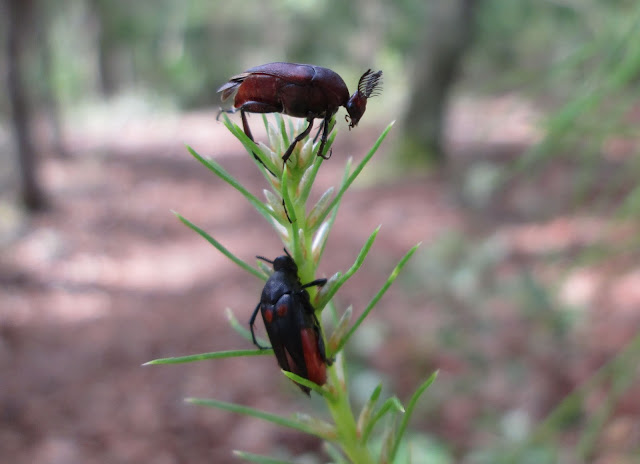Wedge-shaped Beetles, Ripipharidae, Macrosiagon sp.
These bizarre-looking beetles parasitize solitary bees and wasps as larvae. The male (top) has feathery antennae while the female (below) lacks this plumage (though she makes up for it with the sportier colors and spots). They were mating until I disturbed them with my presence. My apologies, beetles.
Rough stink bug, Brochymena sp.
They are quite flat!
Click beetle, Elateridae
This small species of click beetle was all over the park. I'm unsure of its identity, perhaps Limonius?
Firefly, Photuris sp.
Queen Butterly, Danaus gilippus
I find butterflies exceedingly difficult to photograph! This is the best shot I could get.
Many others escaped the camera completely.
Tortoise beetle, Hemisphaerota cyanea
A view of the deer lichen growing on either side of the path, Cladonia sp.
Sawfly larvae - sawflies are 'primitive' wasps
Cow Killer, Dasymutilla occidentalis
Also known by the less impressive name, eastern velvet ant (though they are actually solitary wasps). The above is a female, which are wingless. According to lore, the sting of the cow killer, it being so huge and fiery red and whatnot, is terrible enough to kill a cow...cow killer is a fun name anyhow. The sting is apparently pretty painful, rating 3 out of 4 on both the Starr and the Schmidt sting pain indices, but the venom is not strong enough to kill a person, much less a cow. They're also not very aggressive, though I wouldn't push my luck by handling one.
This is a much smaller species of velvet ant, likely Timulla sp., also a female
Several male velvet ants were flying around the area,
but they never kept still long enough for a portrait.
Much like those uppity butterflies.
Smoky-winged dancer, Argia fumipennis fumipennis
This damselfly confused me in the field; I did not realize the small dancers could have black wings like the much larger Calopteryx (jewelwings). (Side note: many things confuse me in the field!)
A very small cicada skin I noticed on my way out.













Comments
Post a Comment